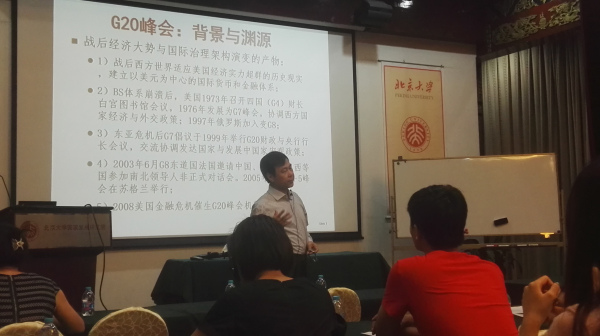
Lu Feng, a respected economist on Open Macroeconomics from China Center for Economic Research of Peking University (CCER) is responding to the media's questions.(Photo by Wu Zheyu/chinadaily.com.cn)
An important economic indicators system for structural reform is expected to be highlighted during the G20 summit, some aspects of these indicators were unveiled and showed their potential to fuel the economies of the world, according to exclusive comments made by the advisory team for China's Ministry of Finance to China Daily website.
A press meeting held to help media better understand the main issues to be discussed during the G20 summit, was held by China Center for Economic Research of Peking University (CCER) on August 29, 2016.
Lu Feng, a respected economist on Open Macroeconomics from CCER, and a long-serving advisor to the Ministry of Finance especially for G20 related issues, hosted the meeting and responded to the media's questions about the evolution of G20.
Among the official themes of G20: "Innovative, Invigorated Interconnected and Inclusive", which is named as "4-I", Lu emphasized innovation in growth patterns, adjusting the economic structure and finally formulating a long-term mechanism, not only aiming at solving short-term crisis, is the consensus that both academics and policy makers have already achieved. Particularly, designing a roadmap for structural reform is expected to be a major achievement that China would contribute to not only G20 countries but also the whole world.
While the doubt from both academia and the public has long been focused on whether there would be a quantitative assessment of the structural reform, otherwise it's hard to evaluate the effect of reform's processing. Lou Jiwei, the Finance Minister, used to introduce the progress already achieved in the high-level symposium on structural reform co-hosted by Ministry of Finance, IMF and OECD on February 26 in Shanghai. Namely, 9 preferential areas like fostering openness for trade and investment, labor market reform, and 48 principle guidelines for the structural reform have been formulated. The economic indicators system is going to be launched during the G20 summit. Lu emphasized that this system would play a vital role for accountability within G20 countries.
Lu and his research team have participated in various Working Group Meetings of G20 and joined the design of the economic indicators systems, as he responded to China Daily website's inquiry about the details and specific aspects of these indicators, he said, "The indicators are divided into 12 categories in 4 areas, which include labor productivity, employment rate, government debt, economic disparity and so on."
"The G20 countries agreed to do self-assessment according to this system, then offered the results to other countries to process the peer review for every two years. Related ministries tried to design a weighting compounding variables system, while technically there are some difficulties and several countries also have dissenting voices, so finally we let each category of indicators keep an independent role."
China Daily website also confirmed with an anonymous researcher from OECD who also participated in the Working Group Meetings of G20, "There were some different opinions when we were drafting the indicators system. Both methods have its limitations."
Li Xin, the researcher from Lu's team, further explained this economic indicators system in response to China Daily website's follow-up questions, "The indicators in four areas include result-oriented indicators, like Gini coefficient, and also government oriented, like applying the indicators to assess government works' effect. The reference data comes from the public statistical data of G20 countries, like from the National Bureau of Statistics (NBS). The scope of application would be world-wide, while the ones who are responsible for evaluating according to it are within G20 countries. OECD and IMF would be charge of assessment and supervising this system."
"The previous way to assess how a country achieved its objective of economic growth, is to observe how many strategies they offered to foster economic growth. While from the 2010 G-20 Seoul summit, a total of over 1000 strategies have been raised by the G20 countries, in fact the effects of implementing them are very diverse."
"This system is designed for countries to assess by themselves, giving the different development stages they are faced with. The 12 categories of economic indicators are fixed, while the individual indicators could be chosen by themselves. Like for economic disparity, you could either use Gini index or Theil index."
"I think the most reasonable part of this system is that it offers a consistent criteria for each country to clearly recognize its own development trend,"Li summarized when China Daily website asked for her personal evaluation of the system.


















































